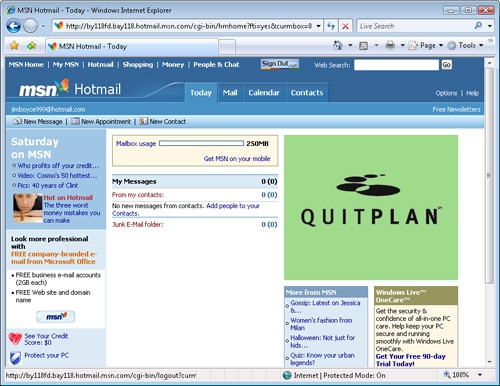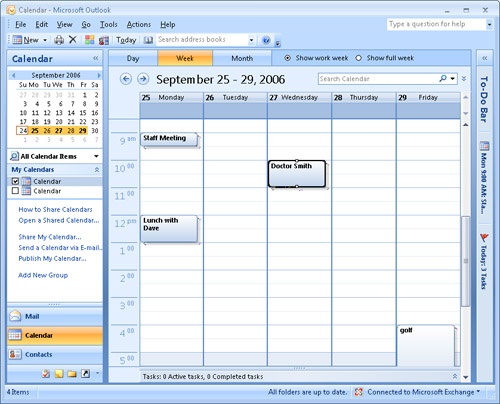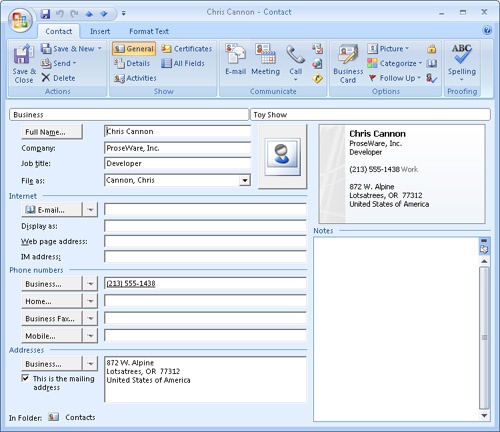This chapter provides an overview of the architecture in Microsoft® Office Outlook® 2007 to help you learn not only how Office Outlook 2007 works but also how it stores data. Having that knowledge, particularly if you’re charged with administering or supporting Outlook 2007 for other users, will help you use the application more effectively and address issues related to data storage and security, archiving, working offline, and moving data between installations.
This chapter also explains the different options you have for connecting to e-mail servers through Outlook 2007 and the protocols—Post Office Protocol 3 (POP3) and Internet Message Access Protocol (IMAP), for example—that support those connections. In addition to learning about client support and the various platforms on which you can use Outlook 2007, you’ll also learn about the options that are available for starting and using the program.
If you’re anxious to get started using Outlook 2007, you could skip this chapter and move straight to Chapter 3, to learn how to configure your e-mail accounts and begin working with Outlook 2007. However, this chapter provides the foundation on which many subsequent chapters are based, and reading it will help you gain a deeper understanding of what Outlook 2007 can do so that you can use it effectively and efficiently.
Outlook 2007 was once primarily a tool for managing personal information such as contacts and e-mail, scheduling, and tasks. Today, Outlook 2007 provides all of these features but adds the benefits of enhanced collaboration. This collaboration comes in the form of group scheduling, data sharing, shared calendars, Microsoft Office InfoPath® forms integration, and Microsoft Office SharePoint® integration. While the capability to manage your e-mail, contacts, calendar, and tasks is still important, the ability to collaborate with your coworkers and business partners can be even more important.
Outlook 2007 provides a broad range of capabilities to help you manage your entire workday. In fact, a growing number of Microsoft Office system users work in Outlook more than 60 percent of the time. An understanding of the Outlook 2007 capabilities and features is important not only for using the Microsoft Office system effectively but also for managing your time and projects. The following sections will help you learn to use the features in Outlook 2007 to simplify your workday and enhance your productivity.
One of the key features Outlook 2007 offers is messaging. You can use Outlook 2007 as a client to send and receive e-mail through a variety of services. Outlook 2007 offers integrated support for the e-mail services covered in the sections that follow.
Note
A client application is one that uses a service provided by another computer, typically a server.
Outlook 2007 integrates tightly with Microsoft Exchange Server, which means that you can take advantage of workgroup scheduling, collaboration, instant messaging, and other features offered through Exchange Server that aren’t available with other clients. For example, you can use any POP3 e-mail client, such as Microsoft Outlook 2007 Express or Microsoft Windows® Mail (the Windows Vista™ incarnation of Outlook Express), to connect to a computer running Exchange Server (assuming that the Exchange Server administrator has configured the server to allow POP), but you’re limited to e-mail only. Advanced workgroup and other special features—being able to recall a message before it is read, use public folders, view group schedules, and use managed folders for archiving and retention, for example—require Outlook 2007.
Outlook 2007 provides full support for Internet e-mail servers, which means that you can use Outlook 2007 to send and receive e-mail through mail servers that support Internet-based standards, such as POP3 and IMAP. What’s more, you can integrate Internet mail accounts with other accounts, such as an Exchange Server account, in order to send and receive messages through multiple servers. For example, you might maintain an account on Exchange Server for interoffice correspondence and use a local Internet service provider (ISP) or other Internet-based e-mail service for messages outside your network. Or perhaps you want to monitor your personal e-mail along with your work-related e-mail. In that situation, you would simply add your personal e-mail account to your Outlook 2007 profile and work with both simultaneously. You can then use rules and custom folders to help separate your messages.
Note
For more information about messaging protocols such as POP3 and IMAP, see the section "Understanding Messaging Protocols" later in this chapter.
Outlook 2007 supports Hypertext Transfer Protocol (HTTP)–based e-mail services, such as Microsoft Hotmail®. HTTP is the protocol used to request and transmit Web pages. This means that you can use Outlook 2007 to send and receive e-mail through Hotmail and other HTTP-based mail servers that would otherwise require you to use a Web browser to access your e-mail, as shown in Figure 2-1. In addition, you can download your messages to your local Inbox and process them offline, rather than remaining connected to your ISP while you process messages. Another advantage is that you can keep your messages as long as you want—most HTTP-based messaging services, including Hotmail, purge read messages after a given period of time. Plus, HTTP support in Outlook 2007 lets you keep all your e-mail in a single application. Currently, Outlook 2007 directly supports Hotmail. Check with your e-mail service to determine whether your mail server is Outlook 2007–compatible.
Outlook 2007 includes a Fax Mail Transport provider, which allows you to send faxes from Outlook 2007 using a fax modem. In addition, third-party developers can provide Messaging Application Programming Interface (MAPI) integration with their fax applications, allowing you to use Outlook 2007 as the front end for those applications to send and receive faxes. Both Microsoft Windows XP and Windows Vista include built-in fax services that support sending and receiving faxes. Both of these fax services can print incoming faxes and deliver a copy to a file folder, but neither will deliver faxes to your Outlook mailbox.
If you need to be able to deliver incoming faxes to your mailbox, you must use a third-party, MAPI-capable fax application. Or, if you use Exchange Server, you can choose a server-side fax application to provide fax support and delivery.
The Outlook 2007 design allows developers to support third-party e-mail services in Outlook 2007. Whatever your e-mail server type, Outlook 2007 provides a comprehensive set of tools for composing, receiving, and replying to messages. Outlook 2007 provides support for rich-text and HTML formatting, which allows you to create and receive messages that contain much more than just text, as shown in Figure 2-2. For example, you can send a Web page as a mail message or integrate sound, video, and graphics in mail messages. Outlook 2007 support for multiple address books, multiple e-mail accounts, and even multiple e-mail services makes it an excellent messaging client, even if you forgo the application’s many other features and capabilities.
Scheduling is another important feature in Outlook 2007. You can use Outlook 2007 to track both personal and work-related meetings and appointments, as shown in Figure 2-3, whether you are at home or in the office—a useful feature even on a stand-alone computer.
Where the Outlook 2007 scheduling capabilities really shine, however, is in group scheduling. When you use Outlook 2007 to set up meetings and appointments with others, you can view the schedules of your invitees, which makes it easy to find a time when everyone can attend. You can schedule both one-time and recurring appointments. All appointments and meetings can include a reminder with a lead time that you specify, and Outlook 2007 will notify you of the event at the specified time. You can process multiple reminders at one time, a useful feature if you’ve been out of the office for a while.
Organizing your schedule is also one of Outlook 2007’s strong suits. You can use categories to categorize appointments, events, and meetings; to control the way they appear in Outlook 2007; and to perform automatic processing. Color labels allow you to identify quickly and visually different types of events on your calendar.
In addition to managing your own schedule, you can delegate control of the schedule to someone else, such as your assistant. The assistant can modify your schedule, request meetings, respond to meeting invitations, and otherwise act on your behalf regarding your calendar. Not only can others view your schedule to plan meetings and appointments (with the exception of items marked personal), but also you can publish your schedule to the Web to allow others to view it over an intranet or the Internet, as shown in Figure 2-4.
Being able to manage contact information—names, addresses, and phone numbers—is critical to other aspects of Outlook 2007, such as scheduling and messaging. Outlook 2007 makes it easy to manage contacts and offers flexibility in the type of information you maintain. In addition to basic information, you can also store a contact’s fax number, cell phone number, pager number, Web page URL, and more, as shown in Figure 2-5. You can even include a picture for the contact.
In addition to using contact information to address e-mail messages, you can initiate phone calls using the contacts list, track calls to contacts in the journal, add notes for each contact, use the contacts list to create mail merge documents, and perform other tasks. The Contacts folder also provides a means for storing a contact’s digital certificate, which you can use to exchange encrypted messages for security. Adding a contact’s certificate is easy—when you receive a digitally signed message from the contact, Outlook 2007 adds the certificate to the contact’s entry. You can also import a certificate from a file provided by the contact.
Note
For details about digital signatures and encryption, see the section "Message Encryption" later in this chapter. For complete details on how to use the journal, see Chapter 23.
Managing your workday usually includes keeping track of the tasks you need to perform and assigning tasks to others. Outlook 2007 makes it easy to manage your task list. You assign a due date, start date, priority, category, and other properties to each task, which makes it easier for you to manage those tasks, as shown in Figure 2-6. As with meetings and appointments, Outlook 2007 keeps you informed and on track by issuing reminders for each task. You control whether the reminder is used and the time and date it’s generated, along with an optional, audible notification. You can designate a task as personal, preventing others from viewing the task in your schedule—just as you can with meetings and appointments. Tasks can be one-time or recurring events.
If you manage other people, Outlook 2007 makes it easy to assign tasks to other Outlook 2007 users. When you create a task, simply click Assign Task, and Outlook 2007 prompts you for the assignee’s e-mail address. You can choose to keep a copy of the updated task in your own task list and receive a status report when the task is complete.
Note
To learn more about how to assign tasks, see "Assigning Tasks to Others" in Chapter 22.
Keeping track of events is an important part of managing your workday, and the Outlook 2007 journal makes it simple. The Journal folder allows you to keep track of the contacts you make (phone calls, e-mail messages, and so on), meeting actions, task requests and responses, and other actions for selected contacts, as shown in Figure 2-7. You can also use the journal to track your work in other Microsoft Office system applications, giving you a way to track the time you spend on various documents and their associated projects. You can have Outlook 2007 add journal items automatically based on settings that you specify, and you can also add items manually to your journal.
When you view the journal, you can double-click a journal entry to either open the entry or open the items referred to by the entry, depending on how you have configured the journal. You can also configure the journal to automatically archive items in the default archive folder or in a folder you choose, or you can have Outlook 2007 regularly delete items from the journal, cleaning out items that are older than a specified length of time. Outlook 2007 can use group policies to control the retention of journal entries, allowing administrators to manage journaling and data retention consistently throughout an organization.
With Outlook 2007, you can keep track of your thoughts and tasks by using the Notes folder. Each note can function as a stand-alone window, allowing you to view notes on your desktop outside Outlook 2007, as shown in Figure 2-8. Notes exist as individual message files, so you can copy or move them to other folders, including your desktop, or easily share them with others through network sharing or e-mail. You can also incorporate the contents of notes into other applications or other Outlook 2007 folders by using the Clipboard. For example, you might copy a note regarding a contact to that person’s contact entry. As you can with other Outlook 2007 items, you can assign categories to notes to help you organize and view them.








